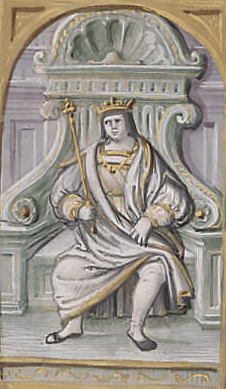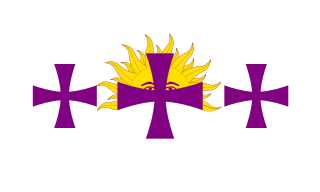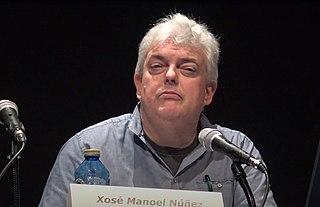

Castilian nationalism or "Castilianism" (Spanish: castellanismo) is a fringe political movement [2] that advocates for the national recognition of Castile, and in some cases, its independence from Spain.


Castilian nationalism or "Castilianism" (Spanish: castellanismo) is a fringe political movement [2] that advocates for the national recognition of Castile, and in some cases, its independence from Spain.
The 19th century saw the development of what historian Celso Almuiña terms as a Castilian "regio-nationalism", fostered by a sense of grievance against Catalonia among the Conservative milieus (supportive of the protectionist interests of the flour-making Bourgeoisie) who pitted themselves against central power in the wake of the 1843 freetrading policies brought forward by Espartero. [3]
During the Second Republic, Castilian nationalist postulates were fringe, adopting a merely "mimetic and defensive" role that tended to fade towards otherwise strongly anti-Catalanist regionalist stances, just as it had been previously the case with the messages of Burgos (1918) and Segovia (1919). [4]
A new sovereignist and internationalist leftist iteration of Castilianism, characterised by the most radical rejection of the identification of 'Castile' with 'Spain' (referred to as Spanish State among its followers), emerged after the creation of Castilian Popular Unity (UPC) in 1983, and, most notably, Castilian Left (IzCa) in 2000. [5]
Castile or Castille is a territory of imprecise limits located in Spain. The use of the concept of Castile relies on the assimilation of a 19th-century determinist geographical notion, that of Castile as Spain's centro mesetario with a long-gone historical entity of diachronically variable territorial extension.

Valladolid is a municipality in Spain and the primary seat of government and de facto capital of the autonomous community of Castile and León. It is also the capital of the province of Valladolid. It has a population of 295,639 people.

Castile and León is an autonomous community in northwestern Spain.

Ferdinand IV of Castile called the Summoned, was King of Castile and León from 1295 until his death.

Henry III of Castile, called the Suffering due to his ill health, was the son of John I and Eleanor of Aragon. He succeeded his father as King of Castile in 1390.

Alfonso of León, Lord of Molina was an infante (prince) of León and Castile, the son of King Alfonso IX of León and his second wife Queen Berengaria of Castile. He was the brother of King Ferdinand III of Castile and León, and father of Queen Maria of Molina, wife of King Sancho IV. He became Lord of Molina and Mesa after his first marriage to Mafalda González de Lara, the heiress of those lands.

The Castilian Left is a leftist nationalist political movement active in the Spanish autonomous communities of Castile-La Mancha, Castile and Leon and Community of Madrid. It strives to advocate for the national recognition of Castile, and in some cases, its independence. Other current political parties include Tierra Comunera, Castilian Party, and Ahora Castilla.

María Alfonso Téllez de Meneses, known as María de Molina, was queen consort of Castile and León from 1284 to 1295 by marriage to Sancho IV of Castile, and served as regent for her minor son Ferdinand IV and later her grandson Alfonso XI of Castile (1312-1321).

Hispanidad is a Spanish term describing a shared cultural, linguistic, or political identity among speakers of the Spanish language or members of the Hispanic diaspora. The term can have various, different implications and meanings depending on the regional, socio-political, or cultural context in which it is used.

Pedro Fernández de Castro "the Castilian" was a Castilian nobleman, son of Fernando Rodríguez de Castro and Estefanía Alfonso la Desdichada. He inherited the Infantazgo of León from his parents and was mayordomo mayor of Fernando II and his son Alfonso IX of León.

The Battle of Moclín, also known as the Disaster of Moclín, was a battle fought in the Granadian municipality of Moclín on 23 June 1280. The battle pitted the troops of the Emirate of Granada, commanded by Muhammad II, the Sultan of Granada, against those of the Kingdom of Castile and the Kingdom of León who were composed mainly of mercenaries and of members of the Order of Santiago, being commanded by the contemporary grand master of the order Gonzalo Ruiz Girón and by Sancho, son of King Alfonso X of Castile.

Philip of Castile was an Infante of Castile and son of Ferdinand III, King of Castile and León, and his first queen, Beatrice of Swabia. He was Lord of Valdecorneja, and, according to some sources, Knight of the Order of the Temple, in one of those churches, the Church of Santa María la Blanca in Villalcázar de Sirga, he was buried in a coffin adorned with emblems of the Templars.

Juan Núñez I de Lara y León, also known as "el Gordo" or "the Fat", was a Spanish noble. He was the head of the House of Lara, Lord of Lerma, Amaya, Dueñas, Palenzuela, Tordehumos, Torrelobatón, and la Mota. He was further known as Señor de Albarracín through his first marriage with Teresa Álvarez de Azagra.

Alfonso de Castilla y Molina was a Spanish noble in the service of the Kingdom of Castile. He was an Infante de Castilla, son of King Sancho IV de Castilla, King of Castile and of his wife, the Queen María de Molina.

María Díaz II de Haro was a Spanish noble of the House of Haro. She was the daughter of Juan de Castilla y Haro and his wife, Isabel of Portugal and was Lady of Biscay from 1334 until her death in 1348.

Javier Moreno Luzón is a Spanish historian, professor of the History of Thought and Social and Political Movements at the Complutense University of Madrid. He is an expert in the political history of Restoration Spain.
The history of the far-right in Spain dates back to at least the 1800s and refers to any manifestation of far-right politics in Spain. Individuals and organizations associated with the far-right in Spain often employ reactionary traditionalism, religious fundamentalism, corporate Catholicism, and fascism in their ideological practice. In the case of Spain, according to historian Pedro Carlos González Cuevas, the predominance of Catholicism played an essential role in the suppression of external political innovations such as Social Darwinism, positivism, and vitalism in Spanish far-right politics.

Xosé Manoel Núñez Seixas is a Spanish historian who specializes in nationalism studies, the cultural history of war and violence, and migration studies.
Libertad was a Spanish newspaper published in Valladolid between 1931 and 1979. Originally founded by the fascist leader Onésimo Redondo as a weekly of fascist, pro-Nazi and anti-Semitic ideology, during the Civil War it became a daily newspaper. It continued to be published until its disappearance in 1979, after the end of the Franco regime.